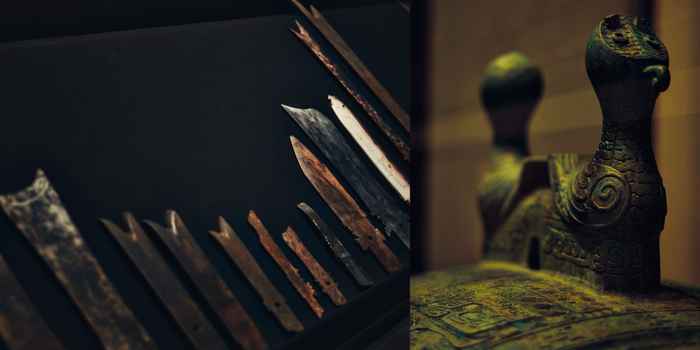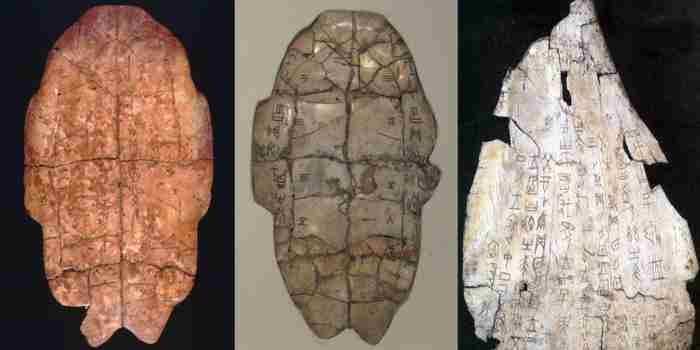Chinese Dynasty: Shang Dynasty (1600 to 1046 BCE)
The Shang Dynasty (商, Shāng), also known as Yin Shang (殷商 Yīn Shāng), was a Chinese dynasty that existed from around 1600 to 1046 BCE. It was founded by Tang of Shang (or Cheng Tang), 商汤 Shāng Tāng (or 成汤, Chéng Tāng), and was centered in north China along the Yellow River valley, the so-called cradle of Chinese civilization.

Left: a portrait of Shang Tang. Right: Shang Dynasty map.
It was the second dynasty of China, following the Xia Dynasty, and the first Chinese dynasty with direct written records.
The Shang Dynasty heralded the Bronze Age in China. It was known for its advances in bronze technology, writing, math, astronomy, artwork, and military technology. The Shang Dynasty is the earliest dynasty in Chinese history that can be verified through written and archaeological evidence. It is considered a crucial period in the development of Chinese civilization, and its legacy can still be seen in modern-day China.
Bronze Technology

Bronze work from the Shang Dynasty
One of the most notable Shang Dynasty achievements was its advanced bronze technology. The Shang people were skilled metalworkers who created a wide variety of bronze vessels, weapons, and tools. These items were not only functional, but they were also highly decorative and often featured intricate designs and inscriptions.
The Shang perfected a technique known as piece-mold casting, which was complex and involved several steps. First, a clay mold was created with the desired shape and design. Then, the mold was filled with molten bronze, which was heated to over 1000 degrees Celsius. Finally, the bronze object was polished and decorated with designs and inscriptions. The artistry and workmanship of the bronze pieces reveal the Shang's mastery of bronze technology.
The Shang Dynasty's bronze technology was used for both practical and ceremonial purposes. Bronze vessels, for example, were used for food and drink at rituals including for burial, celebration, religious divination, and ancestor worship. They were often decorated with scenes from mythology and history. Bronze weapons, on the other hand, were used in warfare and were often inscribed with the name of the king who commissioned them.
Additionally, bronze represented powder during the Shang Dynasty. The Shang rulers monopolized the use of bronze tools and weapons while their farmer subjects used only implements made from stone.
Oracle Bone Inscriptions

Oracle bone inscriptions and the Shang character (商) in different writing styles
Another significant achievement of the Shang Dynasty was its sophisticated writing system. The Shang people used a form of writing known as oracle bone inscriptions, which are the earliest known examples of Chinese writing.
Oracle bone inscriptions were written on turtle shells and animal bones and were used for divination purposes. The Shang people believed that they could communicate with their ancestors and the gods by writing questions on the bones and heating them until they cracked. The cracks were then interpreted as answers to the questions.
The oracle bone inscriptions are valuable historical records that provide insights into the lives and beliefs of the Shang people. They contain information about the Shang Dynasty's politics, economy, society, religion, and culture.
By comparing and equating the inscriptions to modern Chinese characters, scholars have shown that the Shang had already developed all the principles of the modern writing system used today.
Religion and Culture

Oracle bone inscriptions and divination rituals
The Shang Dynasty was an important period for the development of Chinese religion and culture. The Shang people believed in a pantheon of gods and spirits and conducted elaborate ancestor worship rituals.
The Shang people believed that their ancestors had the power to influence their lives and could help them in times of need. They conducted ancestor worship ceremonies in which they offered sacrifices to their ancestors and asked for their guidance and protection. The divination rituals using oracle bone inscriptions described above are an example of such ancestor worship rituals.
The Shang people also held belief in an afterlife, which is indicated by the elaborate burial tombs built for deceased rulers. A ruler's remains typically are accompanied by carriages, utensils, sacrificial vessels, and weapons, so that they would come together in the afterlife.
Overall, the religion during the Shang Dynasty was polytheistic, meaning that the Shang people believed in many gods. People mainly worship Shang Di (上帝, Shàng Dì, the High God), gods of nature, and ancestors. These gods and spirits were believed to have control over different aspects of the natural world and were worshipped through offerings and sacrifices.
Legacy
The final king in the Shang lineage, King Di Xin (帝辛, Dì Xīn), also known as King Zhou (纣, Zhòu), was considered a cruel leader who enjoyed torturing people, leading to calls for the end of his rule. Entrusted with an outpost to protect the western frontier of the kingdom, the Zhou (周, Zhōu) army, led by King Wu (周武王, Zhōu Wǔ Wáng), marched on the capital city. The Shang army was defeated, and King Di Xin committed suicide by setting fire to his palace Lutai (鹿台, lù tái).
As such, the Shang Dynasty came to its end in 1046 BCE, and the Zhou Dynasty was established.
Despite its relatively short duration, the Shang Dynasty had a significant impact on Chinese history and culture.

Artwork and artifacts from the Shang Dynasty
The Shang Dynasty's legacy can be seen in many aspects of modern-day Chinese culture. The Chinese writing system, which was developed during the Shang Dynasty, is still used today and is one of the oldest writing systems in the world. The Shang Dynasty's bronze art and technology were also influential and have been studied and admired by scholars and art historians for centuries.
The Shang Dynasty's religious and cultural practices also continue to influence Chinese culture today. Ancestor worship is still an important part of Chinese culture, and many Chinese people still believe in the power of their ancestors to influence their lives. Chinese mythology, which was developed during the Shang Dynasty, is still an important part of Chinese culture and is celebrated in festivals and ceremonies throughout the country.